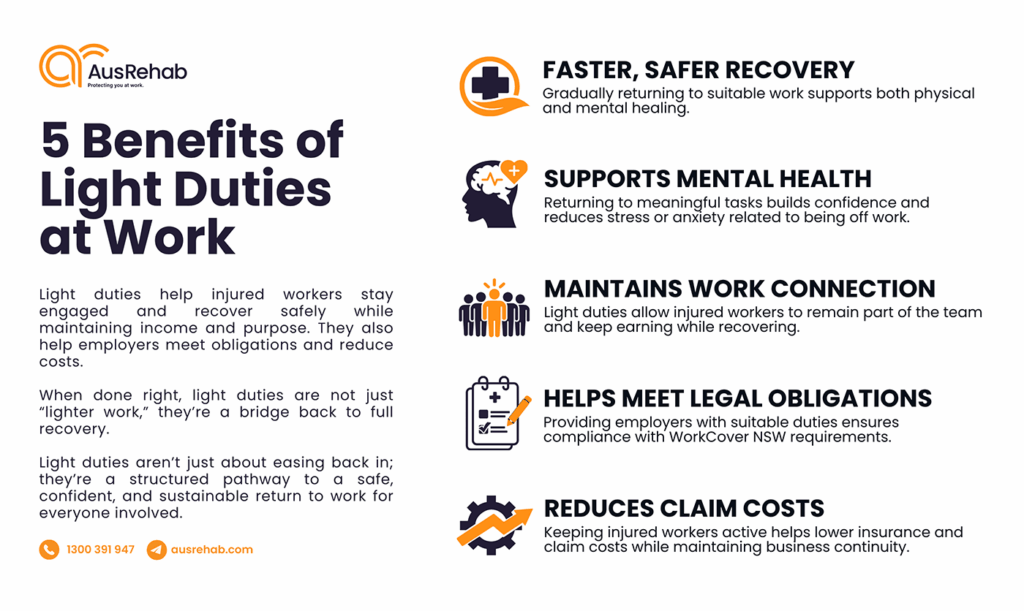• 13 min read
WorkCover Light Duties – What It Is and Why It Matters
-
By Suzzy at AusRehab

Getting injured at work doesn’t always mean you have to stop working entirely. In fact, under WorkCover NSW, many injured workers can safely continue working through something called light duties, which means modified or alternative roles that fit their medical capacity.
Light duties at work are designed to help you stay active, connected, and confident during recovery. Staying engaged helps you maintain your routine, income, and sense of purpose, which can all contribute to a smoother return to full duties.
For employers, offering suitable duties in NSW helps meet WorkCover obligations, reduce claim costs, and maintain productivity. It also shows genuine commitment to employee well-being and recovery.
Let’s break down what light duties mean, how they work under WorkCover NSW, and how AusRehab helps employers and workers design safe, structured return-to-work (RTW) plans that support lasting recovery.
What Are Light Duties?
Under WorkCover NSW, light duties refer to modified or alternative roles tailored to an injured worker’s medical restrictions and current capacity. They form an essential part of the return-to-work process, allowing you to stay productive and connected while recovering.
Light duties work restrictions may involve adjusted tasks, reduced hours, or short-term changes in responsibilities based on your Certificate of Capacity. These arrangements ensure you remain safely active without delaying recovery.
Common light duties examples include:
| Type of Duty | Example Task | Purpose |
| Reduced Hours | 4–5 hour shifts | Maintain work routine |
| Administrative | Filing, data entry, or phone support | Avoid physical strain |
| Observation | Supervising or assisting on-site | Stay engaged without exertion |
Each plan is unique and should reflect your medical advice and job requirements. Your Nominated Treating Doctor (NTD), employer, and rehabilitation provider, such as AusRehab, work together to identify suitable duties in NSW that balance safety and recovery.
What Are Light Duties at Work Under WorkCover?
Light duties may include administrative tasks, shorter shifts, or temporary non-physical roles that suit your current work restrictions. They are not meant to replace your job permanently but to help you gradually transition back to full duties with professional guidance and medical approval.
Why Do Light Duties Matter
Light duties help injured workers in their return to work after injury. They’re not just a formality but a proven rehabilitation strategy that benefits both workers and employers under the WorkCover NSW system.
For injured workers, the benefits of light duties under WorkCover include:
- Faster recovery by staying physically and mentally engaged
- Reduced isolation and workplace stress
- Continued income and job connection during recovery
- Greater confidence and motivation to return to full duties
For employers, offering suitable duties helps:
- Meet WorkCover NSW obligations and maintain compliance
- Reduce claim costs and insurance premiums
- Retain skilled staff and sustain productivity
- Demonstrate genuine care for employee well-being
💡 Note: Staying connected to work, even in a modified capacity, supports both physical and psychological recovery and can reduce the time away from full employment.

Do I Get Full Pay While on Light Duties?
Your pay during light duties depends on your Certificate of Capacity, the type of duties available, and your WorkCover claim details. In many cases, workers receive their normal wage or make-up pay through insurer coordination. What matters most is staying engaged with your return-to-work plan, which helps health and financial stability.
Who Determines Light Duties
Light duties are determined through collaboration between medical and workplace professionals to ensure your recovery stays safe and supported.
Your Nominated Treating Doctor (NTD) outlines your work restrictions after injury in the Certificate of Capacity, specifying what tasks you can safely perform and what activities to avoid. Based on this, your employer, insurer, and workplace rehabilitation provider, such as AusRehab, work together to design a suitable duties plan aligned with medical advice.
Regular reviews are carried out to track your progress, update restrictions, and gradually adjust your workload as your recovery improves. This ensures your duties remain safe, meaningful, and consistent with your return-to-work goals.
Who decides what light duties I can do?
Your doctor determines your safe work capacity, and your employer, with support from AusRehab, structures light duties around that medical guidance to promote a safe and effective return to work.
Worker Responsibilities and Rights
While WorkCover light duties are meant to support your recovery, you also have specific responsibilities and rights during the process.
As a worker, you must:
- Perform only the tasks approved in your Certificate of Capacity.
- Communicate any pain or difficulty immediately to your NTD or supervisor.
- Participate actively in your return-to-work plan and attend review appointments as required.
Refusing suitable duties without a medical reason may affect your WorkCover benefits, as participation is part of your rehabilitation obligations. However, this does not mean you must accept unsafe or inappropriate work.
You have the right to:
- Work in a safe and supportive environment, consistent with your medical restrictions.
- Raise concerns if duties cause pain, discomfort, or pose a risk to your recovery.
- Request clarification from your NTD, insurer, or rehabilitation provider if unsure about your responsibilities.
Collaboration and communication are key. You must participate in suitable duties unless your doctor certifies otherwise. If any task feels unsafe, report your concerns to your GP, insurer, or AusRehab immediately.
Can I refuse light duties under WorkCover?
You must participate in suitable duties unless your doctor certifies otherwise. If the assigned tasks are unsafe or beyond your medical limits, you have the right to raise concerns under the safe work light duties policy to ensure your recovery remains the priority.
Employer Obligations Under WorkCover
Under WorkCover NSW, employers have a legal responsibility to support an injured worker’s recovery and return to work through the provision of suitable or “light” duties wherever reasonably practicable. These obligations are outlined in the Workers Compensation Act 1987 (NSW) and Workplace Injury Management and Workers Compensation Act 1998 (NSW).
Providing suitable duties helps injured workers stay productive and financially stable while ensuring compliance with WorkCover obligations for employers. Here are some of the employer obligations:
- Offer Suitable Duties (NSW)
Employers must offer meaningful, safe, and medically appropriate duties to support an injured worker’s recovery at work. Suitable duties may involve reduced hours, modified tasks, or alternative roles aligned with the worker’s certified capacity.
- Document and Communicate in Writing
If an employer cannot provide light duties, they must notify the insurer in writing, outlining why it is not reasonably practicable, just to make sure the insurer can arrange alternative solutions, such as host employment.
- Participate in the Return-to-Work Planning Process
Employers, alongside the NTD, insurer, and workplace rehabilitation provider, must collaborate to design and implement a structured RTW Plan.
- Maintain a Safe and Supportive Workplace
Employers must ensure that offered duties comply with medical restrictions and do not risk re-injury.
What happens if my employer has no light duties available?
If your employer cannot provide suitable duties, the insurer may arrange WorkCover host employment with another business. This arrangement allows you to continue working safely while maintaining your income and recovery progress under a suitable employment workers’ compensation framework.
Duration and Review of Light Duties
The duration of WorkCover light duties depends on the type of injury, recovery rate, and your current work capacity. Your Certificate of Capacity guides these restrictions, outlining what you can safely do and helping monitor progress over time.
Light duties programs are usually reviewed every 2–4 weeks alongside medical updates to ensure your tasks remain safe and appropriate. The goal is to gradually increase work hours and responsibilities. For instance, starting with 4-hour shifts before returning to full-time work, in line with medical recommendations and workplace demands.
How long can you be on light duties in WorkCover NSW?
There is no fixed timeframe, as each case is different. Generally, light duties continue until your doctor confirms full capacity. Regular reviews and updated Certificates of Capacity ensure a safe and steady gradual return to work in NSW.
When Light Duties Are Not Available
In some cases, your employer may not be able to offer suitable light duties that fit your medical restrictions. When this happens, WorkCover NSW and your workplace rehabilitation provider in NSW can help arrange alternative employment options to keep your recovery on track.
You may be placed in a host employment program, where you temporarily work with another business that can provide safe and suitable duties while you recover, maintaining work readiness, confidence, and engagement in the workforce.
If returning to your original job is not possible, WorkCover retraining and upskilling options may be offered. These programs help you develop new skills and prepare for suitable employment after injury, ensuring long-term stability and meaningful work opportunities.
It’s important to communicate early with your insurer or rehabilitation provider to explore all available options and plan the next steps effectively.
What if light duties are not available at my workplace?
When light duties aren’t available, WorkCover may arrange temporary work through a host employer or provide access to retraining programs to help you build new skills and continue progressing toward recovery.
AusRehab’s Role in Supporting Light Duties and Return-to-Work
As a trusted workplace rehabilitation provider in NSW, AusRehab helps injured workers return to meaningful employment safely and confidently. The team works closely with doctors, employers, and insurers to align everyone toward a smooth and sustainable recovery.
Here’s how we support the light duties process:
- Workplace Assessments: Consultants visit the worksite to evaluate the environment, identify safe tasks, and recommend any necessary modifications.
- Suitable Duties Identification: Based on the worker’s restrictions, AusRehab develops a tailored plan outlining duties that match the worker’s current capacity.
- Return-to-Work Planning: The team creates structured programs that guide workers through gradual increases in hours and responsibilities.
- Progress Monitoring: Regular reviews ensure the duties remain appropriate and that the worker is progressing toward full capacity.
- Stakeholder Coordination: AusRehab acts as a liaison between all parties for smooth communication and resolving barriers early.
Together, these help prevent re-injury, reduce claim duration, and promote confidence in returning to work.
Need help identifying suitable light duties?
Contact AusRehab’s workplace rehabilitation team now to book an assessment and create a safe, structured pathway back to work.
📞 1300 391 947
📧 office@ausrehab.com
🔗 Schedule a workplace assessment today.
Frequently Asked Questions (FAQs)
What are examples of light or suitable duties under WorkCover?
Examples of light duties include reduced work hours, administrative tasks such as filing or data entry, or low-impact activities like observation or supervision. These temporary adjustments allow you to stay active and productive while recovering safely within your medical limits.
Why are light duties important for recovery and return to work?
Light duties help you recover faster by keeping you physically active and mentally engaged. They also maintain your income, reduce isolation, and support a smoother transition back to your usual duties as your health improves.
What if light duties are unsafe or too physical?
You should never perform duties that exceed your medical restrictions. If any task feels unsafe or causes discomfort, report it immediately to your GP, employer, or insurer so your return-to-work plan can be reviewed and adjusted appropriately.
How does WorkCover support host employment for injured workers?
When your employer cannot offer suitable duties, WorkCover NSW may arrange a host employment program with another organisation. This placement provides safe, temporary work that keeps you engaged and progressing toward full recovery.
How does AusRehab support employers managing light duties programs?
AusRehab helps employers identify and implement safe, medically appropriate duties through workplace assessments and program monitoring. Their team ensures compliance with WorkCover NSW guidelines while supporting employees’ recovery and successful return to work.
Don’t forget to share!
Subscribe to stay updated on the latest workplace news.

Resolve your work
place injury today
